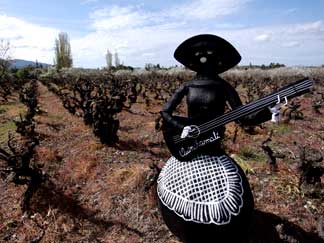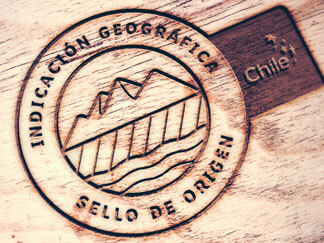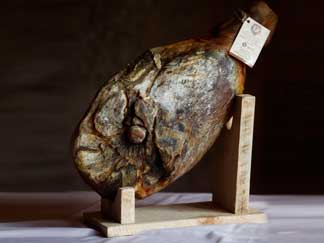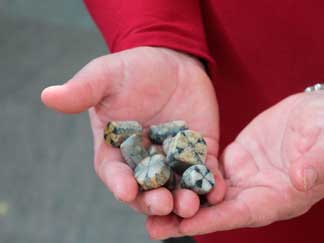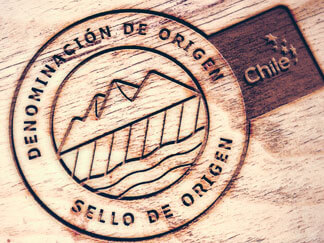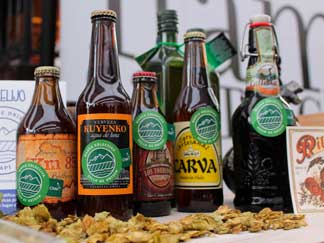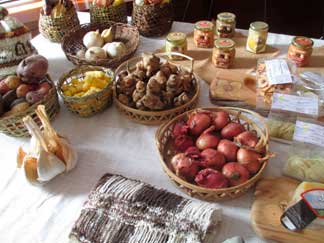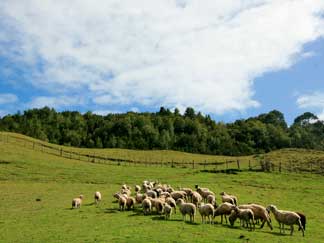Alfarería de Quinchamalí / Quinchamalí pottery
- Applicant: Union of Artisans of Quinchamalí
- Location: Ñuble Province, Bío Bío Region

Quinchamalí is located 35 km southwest of Chillán, Bío Bío Region.
Here, families have inherited the traditional art of clay pottery over the generations.
The ceramics in black clay stand out, made by hand with the help of rustic elements.
The pottery uses clay found in the same location, extracted from the earth in an artisanal manner. Each piece goes through 13 steps, in which the artisans shape it by hand with the help of tools such as pieces of wood, stones, and strips of leather. The deep black color of the pieces is achieved by burning them.
Download list of producers
Tomate Angolino / Angol Tomato
- Applicant: Association of Silvicultural Activities of Malleco (AGRIMA A.G)

The term Tomate Angolino refers to the species known by the scientific name Lycopersicon esculentum Mill of the Solanaceae family and the Cal Ace variety. It is produced in the Angol Renaico Valley, distinguished by the high quality of the variety found in this valley. One of the characteristics of the Angol tomato is its large size and occasionally perfect roundness. It has smooth skin, without deformities. The tomato is very well-adapted to the Angol Renaico Valley, with a somewhat late ripeness starting in February. The fruit is of a flattened spherical shape, with a firm consistency and a pleasant red coloration. Statistically, Angol tomatoes for sale weight around 200 grams (between 170 and 230 grams). As regards the composition of the Angol tomato, it was found to have a higher concentration of lycopene, polyphenols, and antioxidant activity. The Cal Ace variety is an ancient variety of tomato grown all over Chile, but in the soil and climate of Angol it has found a niche allowing it to obtain its level of production and excellent sensory qualities. The geographical area corresponding to this appellation of origin is found in the Araucanía Region, Malleco Province. More specifically, it is found in parts of the communes of Angola and Renaico, being mainly centered around the Angol Renaico Valley.
Prosciutto de Capitán Pastene / Capitán Pastene Prosciutto
- Applicant: Araucanía Regional Government
- Location: Captain Pastene, Araucanía Region

The Capitán Pastene Prosciutto is a charcuterie product made from raw pig’s leg, which is salted, smoked, and matured for 12 to 30 months under the natural conditions in the Nahuelbuta mountain range, where the town of Capitán Pastene in the Lumaco Commune lies. Prosciutto originates from a traditional recipe from the center and north of Italy, and started being produced in Chile by Italian settlers, who founded the town over a century ago. Modifications to the original Italian recipe were introduced, which makes this product unique in Chile and the rest of the world, with a characteristic smoked flavor, matured under the cold air of the Nahuelbuta mountain range without the use of preservatives.
Download list of producers
Piedra Cruz / Piedra Cruz
- Applicant: Arauco Municipality
- Location: Esmeralda 411, Arauco, Bío Bío Region

The Piedra Cruz is a gem (semi-precious stone) extracted from the riverbed of the Las Cruces river. It is formed by a mineral that crystallizes in orthorhombic prisms with a square base or in a rounded shape, with a tone ranging from beige to fleshy pink. Its chemical formula is Al2SiO5 and it is found in low-pressure metamorphic aureoles, showing a series of symmetric carbonaceous inclusions forming a characteristic cross shape in the sections perpendicular to the crystal’s longest side. It has a hardness of 7.5 in the Mohs scale and a density of 3.2 g/cm3 and is generally refractory. It can vary substantially in size, though its diameter is within the range of 1 to 4 cms. Piedra Cruz is used to make jewellery with a base of precious metals such as silver, gold, nickel silver or others, as well as costume jewellery. The geographical zone of the appellation of origin corresponds to Laraquete, a coastal town in the Arauco Commune, Arauco Province, Bío Bío Region. The town has the coordinates 37°09´52.42"S and 73°11´08.20"W, and is located 52.8 kms from Concepción. It borders Lota Commune to the north, Arauco Commune to the south, the Pacific Ocean to the west, and the Nahuelbuta Precordillera to the east.
Sidra de Punucapa / Punucapa Cider
- Applicant: Sociedad Agropecuaria Punucapa S.A.

The word cider comes from the Latin word sicera, which in turn originates from the Hebrew shekar, meaning intoxicating beverage. This refreshing drink is known for its low percentage of alcohol (4 to 5% by volume). It is made artisanally, undergoing a natural fermentation process much longer than that of chicha, from apple juice extracted from the typical varieties of the zone introduced by German and Spanish settlers such as piña, candelaria, limona, norespai, nata, reineta, limón montes, plátano, caramela and cabeza de niño. Punucapa is well-known thanks to its renowned cider, associated with the Fiesta de la Candelaria celebration, an important religious event taking place in February.
Cerveza Valdiviana Región de Los Rios / Valdivian Beer, Los Rios Region
- Applicant: Association of Craft Brewery Developers of the Region of the Rivers or Unión Cervecera de los Ríos A.G.

This mark is used to distinguish beer made from the process of fermenting, using selected yeast, wort from malted barley alone or mixed with other starchy products that can be broken down through enzymatic digestion, having previously been boiled and flavored with hops and/or hop pellets. It is made with water from the Los Rios region and malted barley, hops and/or hop pellets, selected yeasts, and other authorized ingredients whose production is based entirely in the Los Rios region and without the use of assembly plants, in conformity with the production process described in its regulations on its use and management. This recognition is hoped to contribute to rescuing local culture, increase the demand for these original products, and incentivize the establishment of new tourism routes throughout the region.
SIPAM Chiloé / SIPAM Chiloé
- Applicant: Provincial Government of Chiloé
- Location: Chiloé

This mark is used to distinguish traditional products from the island of Chiloé that meet a set of requirements in their production process.
Download list of producers
Cordero chilote / Chiloé Lamb
- Applicant: Ovejero Development Society of Chiloé (SOFOCH)
- Location: Chiloé Province, Los Lagos Region
- E-mail: praderaschiloe@gmail.com
- Contact telephone: 02-9541090

The Chiloé Lamb product refers to carcasses of lambs born to Chiloé sheep and raised in the Province of Chiloé, produced using terminal crossbreeding between a Chiloé sheep and ram and having a live weight between 25 and 35 kgs.
The product possesses a quality that distinguishes it from other types of lamb produced in the country, with the meat being lean, low in intramuscular fat, and having a semi-dry texture.
Download list of producers








